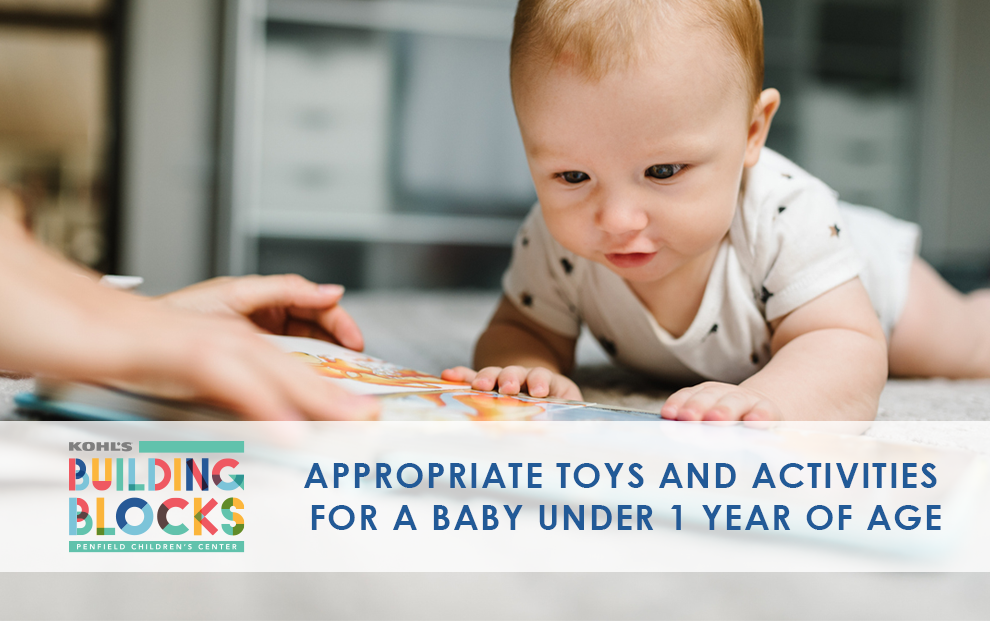
A parent may wonder what kind of toys or activities are important for his/her baby’s development. The answer to that question is simple: parents are the most important people in a baby’s life and can never replace even the most technologically advanced toy or activity. Today’s technology has transformed the types of toys and activities found on the market. While those types of toys may look appealing, it is not as important to have the latest and most expensive technology as it is to embrace toys that help develop a baby’s senses. Toys that are interesting and fun for a baby are the most beneficial. Here are some suggestions of appropriate toys and activities for a baby under 1 year of age:
Vision:
A parent should have the baby look closely at his/her face. The parent can then move his/her face from side to side to have the baby “track” or follow it. A parent can also have the baby look into a small mirror or toy with a mirror. This helps the baby to start learning about his body and develop his eyes.
Grasping:
Small toys or objects such as rings and links, a parent’s finger, rattles, balls (small enough to hold but not large enough to be put in the baby’s mouth) or a baby’s washcloth can be placed in the baby’s hand. The Baby will first hold it in his hand then start to move and shake it and bring it to his mouth.
Oral-Motor Activities:
Parents often wonder if it is okay for their babies to put objects in their mouths. At this tender age of learning, a baby may put many things in his mouth, including hands, a pacifier, even his feet! Many babies will calm or soothe themselves this way and this is very important in finding contentment and happiness. Teethers or toys that have textures are great for a baby to suck, chew or bite. A parent can try a vibrating or cold teether or even a NUK brush, a small white brush with textured “bumps” on the end. It is important to make sure that the baby is not left unattended or given items that are smaller than a small bouncy ball or gum ball as they may be a choking hazard.
Positioning:
A baby’s position should be changed often during the day when he is awake. This allows the baby to develop muscle tone and stimulate senses. Examples include:
- Tummy time lying on a parent’s chest while the baby and parent look face to face.
- Tummy time on the floor, bed or a Boppy pillow with adult supervision for short periods of time.
- Carrying the baby sideways or upright facing away from parent.
- Lying on a parent’s lap either face up or face down.
When positioning a baby, there are a few things parents should keep in mind. If a baby keeps his head turned or tilted to one side most of the time without correction, it may indicate muscle weakness and may require further evaluation from the baby’s pediatrician. A parent should also avoid placing the baby in equipment for long periods of time such as a bouncy seat, exersaucer/walker or a car seat. Parents should try to limit a baby’s time in equipment to 30 minutes or less. There have been some studies done that indicate babies who spent a lot of time in equipment were slower to develop gross motor skills such as rolling, crawling, or walking. When a baby is lying on his back, a parent should try to keep his head in a midline position (straight up and down and not to the side) by placing a small towel roll on one side of his head if it tilts to the side.
Toys/Activities:
Babies love small rattles or toys that play music. They also enjoy easy cause/effect or action toys that they can pull, push or roll and different sized balls that are big enough to avoid a choking hazard. A parent can also blow bubbles while the baby watches.
Simple Games:
“Peek-a-boo,” “Patty-cake” and songs like “Itsy Bitsy Spider” and “Wheels on the Bus” engage a baby and help him learn about language. A parent can sing nursery rhymes, make silly sounds and imitate the sounds a baby makes in response.
What is your favorite activity to do with your baby?
Danita Wendorf is an Occupational Therapist who specializes in pediatrics, specifically brachial plexus injury, Down syndrome and torticollis.


Leave a Reply